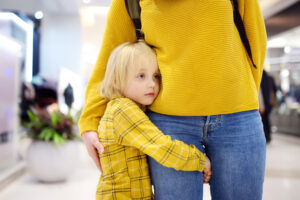Nurturing Resilience: Understanding Anxiety in Children and Effective Treatment Approaches
Anxiety disorders are among the most common mental health issues affecting children worldwide. Recognizing and addressing anxiety in children is essential for promoting healthy development and well-being. This article explores the symptoms, treatment options, and therapeutic approaches for managing anxiety in children, drawing upon evidence-based practices and expert insights.
Understanding Anxiety in Children:
Anxiety in children manifests in various ways, often characterized by excessive worry, fear, and apprehension. While some degree of anxiety is a normal part of childhood development, persistent and overwhelming anxiety can significantly impact a child’s daily functioning and quality of life. Common symptoms of anxiety in children include:
- Excessive Worry: Children may experience persistent and intrusive worries about various aspects of their lives, such as school performance, social interactions, or safety.
- Physical Symptoms: Anxiety often manifests physically, leading to symptoms such as stomach aches, headaches, muscle tension, fatigue, and difficulty sleeping.
- Avoidance Behaviours: Children with anxiety may avoid situations or activities that trigger their fears or discomfort, leading to social withdrawal, academic difficulties, or disruptions in daily routines.
- Irritability and Restlessness: Anxiety can manifest as irritability, mood swings, or restlessness in children, affecting their ability to concentrate, engage in activities, or interact with others.
Types of Anxiety Disorders in Children:
Several types of anxiety disorders can affect children, each characterized by distinct symptoms and triggers:
Generalized Anxiety Disorder (GAD): Children with GAD experience excessive worry and anxiety about various aspects of their lives, including academic performance, social relationships, and future events.
Separation Anxiety Disorder: Separation anxiety involves intense fear or distress when separated from primary caregivers or familiar environments, often leading to reluctance or refusal to attend school or participate in activities away from home.
Social Anxiety Disorder: Social anxiety manifests as fear or avoidance of social situations or interactions, leading to feelings of self-consciousness, embarrassment, or rejection in social settings.
Specific Phobias: Children may develop specific phobias characterized by intense fear or anxiety related to specific objects, animals, situations, or activities (e.g., fear of spiders, heights, or public speaking).
Treatment Options for Childhood Anxiety:
Effective treatment for childhood anxiety typically involves a multimodal approach tailored to the child’s specific needs and circumstances. Key treatment options include:
Cognitive-Behavioural Therapy (CBT): CBT is a well-established, evidence-based therapy for childhood anxiety, focusing on identifying and challenging maladaptive thoughts and behaviours. CBT interventions may include exposure therapy, cognitive restructuring, relaxation techniques, and social skills training.
Eye Movement Desensitization and Reprocessing (EMDR): The application of EMDR in treating anxiety in children has gained recognition as an effective therapeutic intervention. EMDR, originally developed to address trauma-related symptoms in adults, has been adapted and tailored to suit the developmental needs of children experiencing anxiety disorders. Through the use of bilateral stimulation, such as eye movements, taps, or auditory tones, EMDR helps children process distressing experiences and alleviate associated anxiety symptoms. By engaging in guided imaginal exposure or narrative techniques, children are gently encouraged to recall anxiety-provoking situations while simultaneously focusing on bilateral stimulation. This process enables children to reprocess the anxious memories, regulate their emotional responses, and develop adaptive coping mechanisms. Moreover, EMDR’s non-invasive nature and child-friendly approach make it well-suited for younger populations who may struggle with traditional talk therapies. Research supports the efficacy of EMDR in reducing anxiety symptoms and improving overall functioning in children, highlighting its value as a promising intervention for addressing childhood anxiety disorders.
Parental Involvement and Support: Parental involvement is crucial in supporting children with anxiety, providing reassurance, validation, and encouragement. Parent training programs can equip parents with skills and strategies to help their children manage anxiety effectively.
Medication: In some cases, medication may be prescribed to alleviate symptoms of anxiety in children, particularly when symptoms are severe or significantly impairing daily functioning. Selective serotonin reuptake inhibitors (SSRIs) are commonly used medications for childhood anxiety, prescribed under close medical supervision.
Mindfulness and Relaxation Techniques: Mindfulness-based interventions and relaxation techniques, such as deep breathing exercises, progressive muscle relaxation, and guided imagery, can help children manage stress, reduce anxiety levels, and enhance emotional regulation skills.
Conclusion:
Anxiety disorders are prevalent among children and can have a significant impact on their emotional well-being and functioning. By recognizing the symptoms of anxiety in children and implementing appropriate treatment approaches, parents, educators, and mental health professionals can support children in developing resilience, coping skills, and a positive outlook on life.
Author: Ania Harnden, BSocialWork, AMHSW, EMDR Therapist
To book an appointment with Ania, select Online Booking or call Vision Psychology Brisbane on (07) 3088 5422.
References:
American Academy of Child and Adolescent Psychiatry. (2017). Anxiety Disorders in Children. https://www.aacap.org/aacap/families_and_youth/facts_for_families/fff-guide/Anxiety-Disorders-in-Children-007.aspx
Kendall, P. C., & Ollendick, T. H. (2004). Setting the research and practice agenda for anxiety in children and adolescence: A topic comes of age. Cognitive Therapy and Research, 28(2), 119-134.
Silverman, W. K., & Albano, A. M. (1996). The Anxiety Disorders Interview Schedule for Children for DSM-IV: Child and parent versions. Psychological Corporation.
Walkup, J. T., Albano, A. M., & Piacentini, J. (2008). Cognitive-behavioral therapy, sertraline, or a combination in childhood anxiety. New England Journal of Medicine, 359(26), 2753-2766.

